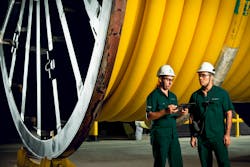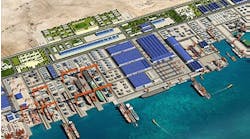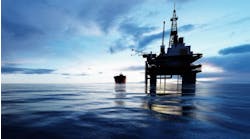New flexible pipe technology designed for challenging environments
Features carbon fiber composite pressure armor layer
Ray Burke, Baker Hughes
The first flexible pipes were used in the offshore oil and gas industry in 1972. These early models were built and applied as a ‘kill and choke’ line and formed with a bonded type of material, usually vulcanized rubber and armoring.
Since then, the demands for this technology have steadily grown and diversified. Today, they are found in every major production basin worldwide and are used for everything from risers, flowlines, fluid transfer lines and jumpers, all designed to keep production flowing efficiently.
The development of flexible pipe technology has accelerated in recent years. Of course, the clear trend across the oil and gas industry has been operators looking for operational efficiencies wherever possible. Marginal gains in operational efficiency have become the order of the day.
However, implementing this is trickier than it may sound given that many new fields are in some of the most challenging environments the industry has ever had to contend with. Deeper water, higher temperatures, higher pressure, aging infrastructure, and complex chemistry all stack up to create ever more intense conditions for flexible pipe to withstand. In short, more and more fields are pushing the boundaries of existing technology. So, is it feasible to expect even more from flexible pipe technology?
Why go flexible?
Every project, at some point, must make a choice between rigid or flexible pipeline. The simplicity of the rigid carbon steel, welded together on a barge or at a spoolbase and then laid on the seabed, has been overshadowed in some cases by the more sophisticated mechanism of a flexible pipe. Installation and operation are simplified by design, before the pipes are constructed and shipped.
The choice of subsea pipeline technology is often based on local conditions, technical requirements, installation vessel availability, operator preferences, and cost efficiency.
The ability to apply flexible pipe in the most challenging environments is a significant part of its appeal. High performance in water depths beyond 2,500 m (8,202 ft), high pressure reaching beyond 10,000 psi, and high temperatures more than 130°C (266°F), as well as the ability to withstand large vessel motions in adverse weather conditions, point toward why flexible pipelines have increased in popularity in recent times.
For floating production, flexible risers are often the only option that solves the geometric constraints of water depth, fluid pressure, vessel motions due to environmental loading, and the consequential fatigue degradation of steel.
Of course, these operating conditions are set against their own challenging backdrop. Even five years after the downturn hit, almost every operator continues to encourage supplier-led solutions to reduce cost and standardize and simplify subsea system installation and operation.
Deeper, higher, hotter
Today, frontier markets such as Latin America, Brazil in particular, and West Africa, epitomize the need for enhanced flexible pipe technology. Operations here typically involve negotiating extremely deep waters, high pressures and very high temperatures, with production to an FPSO. It is because of this that Brazilian projects have often been at the cutting edge of technology developments.
Increased project activity in such complex environments has led to incremental improvement in product capabilities. To date, flexible pipeline has been manufactured from a combination of materials, including steel pressure armor. This gives the designers high stiffness to provide strength, geometric compliance to provide flexibility, and incorporates polymer sealing layers with low stiffness for increased fluid integrity. With the addition of further strength bearing armor layers, this traditional structure is what gives the product its intrinsic properties. However, new operating and economic environments have called for more – deeper, hotter, faster, larger and, of course, cheaper.
It is within this context that Baker Hughes has developed new designs for flexible pipe, moving from purely metallic strength to a carbon fiber composite pressure armor layer, marking a major step-change in the industry.
By developing a composite pressure armor layer, the weight of the riser is reduced by up to 30%, making it easier and less expensive, to transport and install - using smaller vessels or reduced vessel time, fewer ancillaries, and giving the operator a simpler riser configuration to manage. This hybrid composite flexible pipe allows a significant reduction in overall system complexity, allowing operators to move into deeper waters while lowering opex and operational risk.
Furthermore, the composite replaces metallic layers which are susceptible to carbon dioxide (CO2) corrosion, something increasingly encountered in deepwater basins. This may cause stress corrosion cracking unless properly managed. This hybrid riser design, proven with full life-cycle testing, adopts aerospace type materials to reduce permeated gas flow rate through the pipe, reducing operational risk and adding cost benefits over the field lifecycle.
Connection to oil fields
Despite all these advantages, flexible pipes have encountered challenges as they have developed. Like all major oil and gas infrastructure, corrosion and degradation mean integrity management is an area of significant focus and development.
Flexible pipes used for large volume gas export and gas injection can cause flow induced pulsations (FLIP) to occur, which can lead to excessive vibration of small-bore topsides and subsea pipework. Excessive vibration can lead to failure and loss of containment if not caught early. The phenomenon is caused by the interaction of the gas with the cavities of the carcass layer of the flexible pipe and onset occurs above some critical flowrate.
Until recently, operators would have to accept this as a fact of life and manage the consequences through subsea and topsides modifications or place limitations on the flow rate. These conditions, and recent advances in research and development in this area have led to the development of a system called Flex-Insert. In this case, the internal carcass is manufactured with an additional, internal layer within the pipe which effectively removes the cavities and prevents FLIP from occurring, saving time and cost in the process.
Lifetime support
Despite the significant leaps forward in the technology applied to new flexible pipes, there remains the challenge of how best to manage existing, older flexible pipelines. Lines in operation, in almost all cases, have steel components and are afflicted by the age-old issue of sea water corrosion.
The annular space is the key point for integrity and inspection/management strategies. This is the volume between the internal barrier polymer sheath and the outer cover polymer sheath containing the steel wires of the pressure and tensile armor layers. Damage to the outer sheath is one of the main causes of sea water entering the riser, causing corrosion of the armor wires.
An added complication in presalt fields with high CO2 levels, is that the water turns to vapor then mixes with the CO2 before entering the annular space by permeation. This creates a highly acidic, highly corrosive solution in close contact with the armor wires.
Both situations can lead to a flooded annulus. Given the potential consequences of flexible pipe failure, the need for a clear and efficient understanding of the integrity of this outer sheath is critical.
For new pipe projects, Baker Hughes has also developed SPIRE, a new system that allows operators to monitor whether there is water in the pipe annulus, and even determine whether it is a result of gradual permeation or sudden damage to the outer sheath. The SPIRE system contains three hardware components: an in-pipe sensor (FlexSensor) incorporated as part of the pipe construction in the tensile armor wire layer, a connection at the topsides end-fitting (smart bolt) and, either a control room rack (for monitoring) or a portable measurement instrument (for inspection).
The sensors are wrapped around the outside of the pipe, incorporated in the tensile wire layer, before the outer sheath is applied, resulting in a small change to the manufacturing process. The system allows continuous monitoring of the pipework integrity, meaning early intervention is made not only feasible, but highly efficient.
An outer sheath breach puts the tensile armor wires at risk from corrosion and corrosion-fatigue. Amongst a range of solutions for integrity management that the company has, the MAPS technology is designed to provide information about the integrity of the tensile armor wires, making it ideal for cases where there is an outer sheath breach. The underlying MAPS technology – a non-destructive, non-contact technique for the measurement of stress in steel materials, also has ‘reach,’ which is the ability to sense the effect of a wire defect many meters from the actual damage site. This gives it a significant advantage over other inspection techniques as it allows critical areas, such as underneath a bend stiffener, to now be inspected.
Operators are increasingly looking to suppliers who can offer the best overall value across an entire project lifespan. Choosing a product is just one part of the total cost; transportation, installation, and management of integrity make up a significant part of the rest. Today, operators are looking at the bigger picture, how can infrastructure, like flexible pipe, help get the most out of a field, in the most efficient way. Baker Hughes is focused on reducing TOTEX, across the full range of subsea infrastructure throughout its life, these products form a family named Aptara, meaning fit-for-purpose.
Reduced operational, safety and environmental risks while curbing maintenance costs and extending the life of equipment is the optimum solution. With increased speed, flexibility, and performance, these increasingly adaptable systems boost productivity over the expected full life of the field. •




